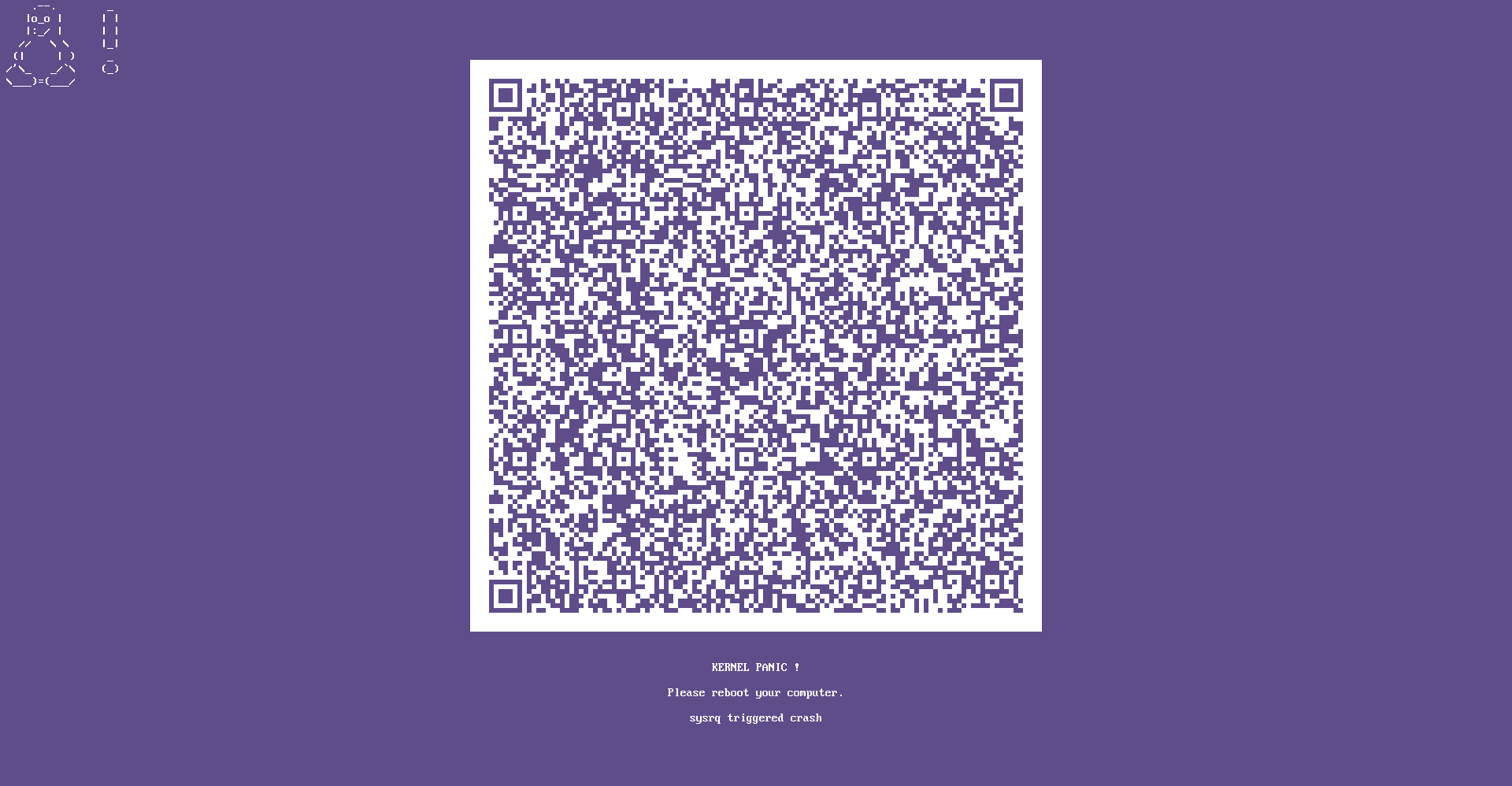- cross-posted to:
- linux@programming.dev
- cross-posted to:
- linux@programming.dev
It is not informative yet, but I like that it’s blue. It’s a quite recognizable color. Windows made it recognizable by having a lot of BSODs. People are asking why it couldn’t be just black, but with non-black BSOD one can recognize it instantly without reading the text.
Just for reference, a few years back, (ex-Microsoft) David Plummer had this historical dive into the (MIPS) origin of the blue color, and how Windows is not blue anymore: https://youtu.be/KgqJJECQQH0?t=780
Oh, thanks! I don’t know much about the current state of Windows.
Hey @Thorned_Rose@sh.itjust.works the last chapter of this video is called redscreen, are you David Plummer? lol
Reminds me of my Windows XP days when I used to customise the hell out of everything I could… custom boot screen… and yes custom BSOD. Which I switched to red 🟥❗ One day my PC RSODs in front of a family member and he said, “Oh shit, that must be really bad if it’s red instead of blue!” 😂
VMware went with Purple for their hypervisors so you get a PSOD instead. Always was fun when you’d hit the console for a server and get greeted by that instead of the yellow and black split screen.
Ahh, that sweet yellow and black split screen 😌
A QR code created from the actual fault text would be super helpful. That way we can scan it and get the full error message (details and all) on another device without having to snap a picture or something. But not like windows does it, where it’s a link to a defunct page. I’m taking about the actual text transcoded into a QR code.
I believe the main contributor for drm_panic wants to add one eventually. Here’s what it might look like:
 https://gitlab.com/kdj0c/panic_report/-/issues/1
https://gitlab.com/kdj0c/panic_report/-/issues/1Also it looks like the colours are configurable at compile time (with white on black default).
Ah man, I was hoping I’d be rickrolled
This looks EXACTLY as I imagined!
And windows shows it for a few seconds, never enough time to pick the phone.
Agreed. Probably the only
One of thegood thing about the win98 BSOD is that it crashed/froze along with the computer, and the PC required a hard reboot. Yeah, I know, not intentional, but it allowed me to fully read the message.Edit: crossout
You have to disable auto reboot on bsod
This should be the default option when the blue screen happened, giving users chance to scan the QR and find out about the causes before they can try restarting their PC
Most users don’t want to immediately troubleshoot every error, they want to get back to work. The ones that do know how to find it in event viewer or the crash dumps or disable auto reboot on bsod.
What’s DRM in this context? Surely linux kernel doesn’t do digital rights management?
Direct Rendering Manager. Part of Linux kernel to communicate with GPUs.
Direct Rendering Manager
DRM came before DRM
Doesn’t matter; I still get triggered by it every time anyway.
Actually there is DRM in the kernel thanks to the HDMI blobs.
Fuck HDMI. The committee makes doing custom hardware near impossible unless you’re a mega corp
It was made by Hollywood for Hollywood.
How do they handle the naming confusion?
It ought to be mandatory to write this out whenever talking about Linux. I’ve seen more than one person bash Linux in a public forum “because it has digital rights management built into the kernel” after they’ve misinterpreted some news headline.
deleted by creator
Of all the things to take from windows, this is one of the better ones. Especially if it gets more info in the future. For less tech-literate users, a screen like this is a lot better than a hard to read dump to a terminal.
They should still include more debugging into.
I’d suggest some kind of “press this key to view debug information” text (or make it documented but not visible, to avoid people just pressing whatever button is written on the screen)
Why? People aren’t idiots. If they don’t know what it means they can look it up or ask for help.
People aren’t idiots. If they don’t know what it means they can look it up or ask for help.
Flip that. People are idiots. If they don’t know what something means, they won’t look it up. Not Desktop Linux users today but, definitely normies if Linux ever comes on a system they buy in the future.
Because for the bulk of users, unless they are power users, all they need to know is that things didn’t work.
Things actually useful to have on the BSOD:
- distro-specific instructions for submitting a bug report
- option to reboot
- option to show debug info
- option to show a qr code that submits a bug report
- and, if configured by the distro or system admin, debug info
How are you going to use your computer when the kernel panics. That’s kind of the problem, it panicked. It would be nice if it rebooted after a minute or two
Any information given would obviously be for use with another device.
QR code, for example. These are instructions or information about the crash, not links (except the QR code, which would obviously be read by another device).
How would a kernel that has already crashed handle keypresses?
I’m not an OS dev, I have no idea how stuff this low-level works.
The kernel art department really failed us here. Instead of a blue screen of death we could’ve had, I don’t know, literally any other colour. I’d have gone with the Puce Screen of Panic.
How about black on white with a clear stack trace visible
That would be far too helpful.
Puce Screen of Panic
That’s class
Guru Meditation red.
Alternately: yellow-and-black ASCII approximating Evangelion’s ALART.
It needs more information about what went wrong. That’s about as useful as a windows BSOD.
I thought for a minute that Linux now panics when trying to play DRM’d content
Also see: systemd-bsod. Generates QR codes, too. I think blue for userspace boot-time errors and black for kernel stuff might be nice.
Did they have to go with such a loud shade of blue? It would look so much better on the eyes if it was a nice deep dark blue.
Tbh I don’t even know why it needs to be blue or any colour at all.
Everyone knows what the blue screen is. This makes the implication when the screen does appear really obvious.
No need to reinvent the wheel.
Agree, the old windows blue screen would sear your retinas, could definitely be tuned down a bit.
Exactly
Black with big white text would be nice
This is the best summary I could come up with:
After being talked about for years of DRM panic handling and coming with a “Blue Screen of Death” solution for DRM/KMS drivers, Linux 6.10 is introducing a new DRM panic handler infrastructure for being able to display a message when a panic occurs.
With Linux 6.10 the initial DRM Panic code has landed as well as wiring up the DRM/KMS driver support for the SimpleDRM, MGAG200, IMX, and AST drivers.
For those curious what DRM Panic can look like in action, Red Hat engineer Javier Martinez Canillas shared a photo of the DRM Panic “Blue Screen of Death” in action.
A BeaglePlay single board computer was used and Javier posted to Mastodon of an example implementation:
It could be extended in the future with some operating systems having looked at QR codes for kernel error messages and other efforts for presenting more technical information while still being user-friendly.
On Linux 6.10+ with platforms having the DRM Panic driver support, this “Blue Screen of Death” functionality can be tested via a route such as echo c > /proc/sysrq-trigger.
The original article contains 231 words, the summary contains 177 words. Saved 23%. I’m a bot and I’m open source!
It’s beautiful. I assume they’ll dump the kernel oops log if there’s any.
They should make it black instead.
I would have gone with red… red = error
That would make it just as hard to read. Black on white offers the most contrast
Gold on purple offers more iirc
I would prefer purple.
Maybe purple with yellow text
Once again, Linux is late with a feature that Microsoft not only has had for years, but is famous for.
Windows is famous in all the wrong ways
Not sure if you’re coming or simping M$
It’s normal for things to implement stuff from each other? 🤷
Microsoft is late with many things too. And I don’t nessesarly think a feature here and there is what makes a good OS, the base stuff is more important.













